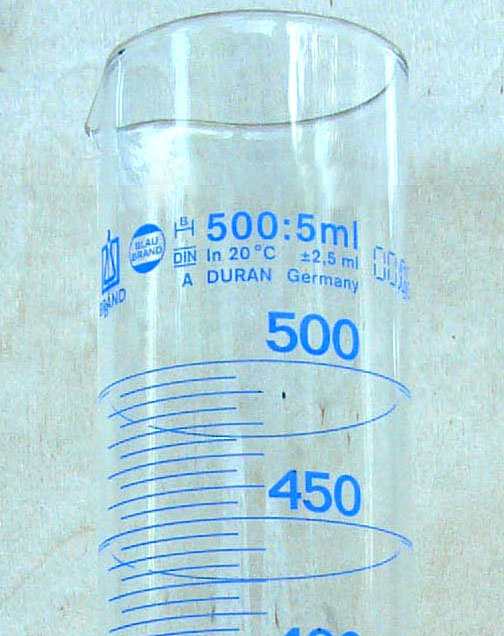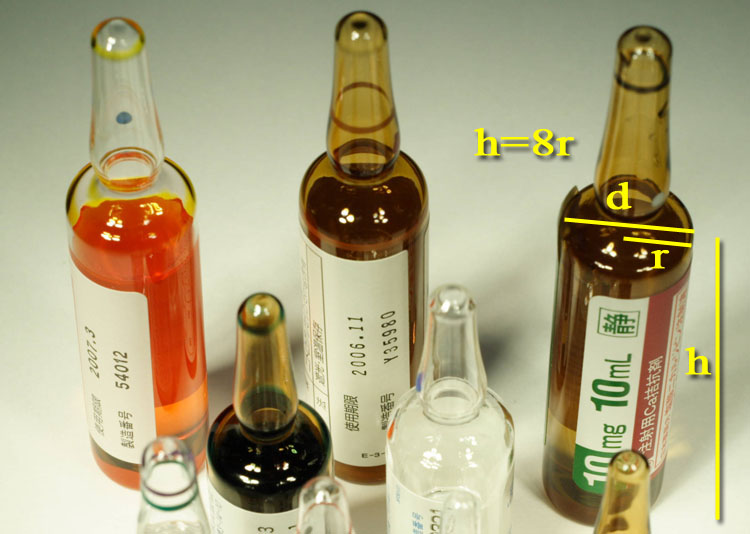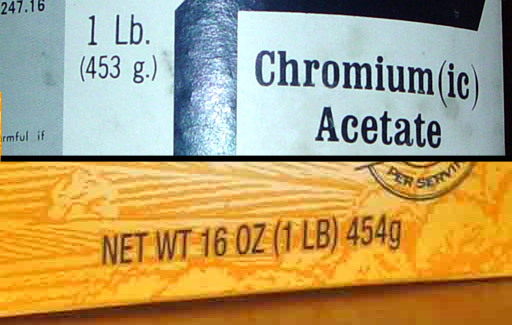

This is a 25 milliliter graduated cylinder. (2a) What is the volume increments between each of the small divisions?
(2b) What is the volume of the liquid in the cylinder?
Note: Both "ml" and "mL" are official abbreviations for milliliter. I prefer "mL" because a lower case "L=l" looks like a "one=1" and the upper case "L" will not be confused with the numeral one "1".

The bottle at the right as 3 volumes written on it, "450 ml 500ml 1000ml" The 450 and 500 are covered with a blue marker. We suspect this means this is bottle is 1000 mL. From the picture, the bottle appears 3 times as wide as the graduated cylinder. The height of the liquid in the bottle appears twice the height of the 50mL mark in the graduated cylinder. Volume of a cylinder is pi x radius2 x height. (4b) What would be the volume of the liquid in the bottle if the bottle is 3 times wider and twice the height? (Hint: You don't need the actual radius and height measurement. In other words, let "R"=graduated cylinder. Then "3R" would be the radius of the bottle. Let H=equal height of 50mL mark, then 2H is height of liquid in bottle.).
(4c) What is HCOOH?



Below are some more ampules. This time these have Chinese writing on them. It's hard to tell how large these are from a photograph. Being 10mL they hold the same as the 10mL graduated cylinders used in labs. So their height would be similar to that.
(7a) So about how many centimeters tall do you think that ampule is (just to the neck)? (Hint: The height looks like 4 times its diameter, which makes it 8 times its radius. Volume of this cylinder is 10cm3=pi x r2 x H. If H is 8 x r, then 10cm3=pi x r2 x 8r. Solve for r, then height will be 8 times larger. .
(7b) Look back on the smaller ampules above. About how tall (in cm) are those ampules (up to the neck)?


Stu came to the party in a graduated cylinder costume. (8a) If his costume goes all the way to the floor, about how many liters would this graduated cylinder hold? (Hint: Assume his chest size (and cylinder size) is 40 inches circumference. Use C=pi x diameter to find diameter. He's 6 ft tall, but the cylinder starts a foot lower and ends at the floor. Use V=pi x r2 x height for volume. Convert inches and feet to centimeters first.)
(8b) Change the liter volume into gallons.

Which is it: You will often see some containers labeled 1 lb (453 g), and others with 1 lb (454 g). (9) Why is there this discrepancy?